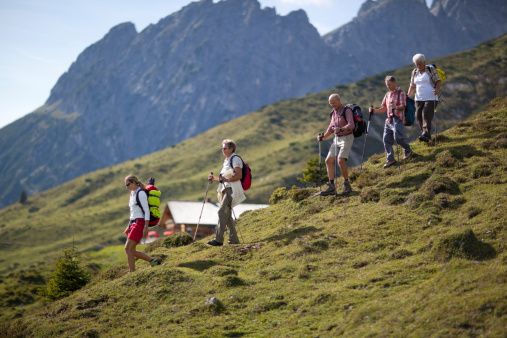 1. Guides demonstrate social intelligence, the ability to build and maintain positive relationships. As expedition participants struggle to reach their objectives through all manner of adversity, guides need to establish personal relationships that don’t fracture easily. Christian Hoogerheyde, a project manager at Socrata, said his Icelandic guide’s social skills continue to “serve as a lesson to me every time I try to establish a new client’s trust.”
1. Guides demonstrate social intelligence, the ability to build and maintain positive relationships. As expedition participants struggle to reach their objectives through all manner of adversity, guides need to establish personal relationships that don’t fracture easily. Christian Hoogerheyde, a project manager at Socrata, said his Icelandic guide’s social skills continue to “serve as a lesson to me every time I try to establish a new client’s trust.”
2. Guides are adaptable, and smoothly change their leadership style as conditions on the mountain change. Doug Coombs, a two-time world extreme ski champion and guide, would teach his clients in the lodge before setting out on an adventure, coaching them on steep snow slopes, and guiding them steadily when things got tough in the field. Seychelle Hicks, a team manager at BloomReach, said her guide experience helped her to more efficiently “adapt to our customers, resourcing demands, and building a self-directed team—and only jumping in when needed.”
3. Guides empower others to reach their own summits. Seven Summits guide Jim Williams said, “Creating the environment that allows a climber to do their best and perform at the highest level possible is the ultimate measure of success as a guide.” Edmund Reese, VP and CFO for U.S. consumer card products at American Express, said, “The leadership lessons taught by both the guides and the mountain itself have honed my focus on embracing the front lines. If we build leadership in others, we develop a stronger line and an overall stronger organization.”
4. Guides are trust-builders. On an expedition with MBAs to remote Navarino Island at the very tip of South America, Chilean guide Feña Yañez told me, “Modeling what trust means is key. It’s never about talking about things. It’s about showing them.” Expedition participant John Sims, Partner and CFO at Snowden Lane, said, “Without trust in your teammates, you only will do as much as faith in your own limited abilities will take you.”
5. Guides are risk-aware and function well in conditions of uncertainty. Lyndsey Bunting, now director of financial analysis at Birchbox, served in the Peace Corps in a remote area of Panama after leaving her job in investment banking. She said, “Whether it’s a skill we’ve had to learn from a tough life like many of the world’s poorest populations, or from mountain climbing, functioning and thriving in uncertainty is something we’re all able to learn.”
6. Guides see the big picture. The wisest guides take a holistic view of the climb. They know when to head for the summit and when it’s time to change directions and head down. Deborah Horn, a manager at Microsoft, said a fierce night storm ended her summit attempt on the Grand Teton. “At our night camp, our guide delivered the message that we would have to end our climb. I learned that even if the summit isn’t attained, the journey is just as valuable and rewarding as standing on the peak.”
CEOs who actively model the leadership strengths of mountain guides not only will enhance their own leadership, but also, as Edmund Reese of American Express said, “build leadership in others,” and “develop a stronger line and an overall stronger organization.”

Chief Executive Group exists to improve the performance of U.S. CEOs, senior executives and public-company directors, helping you grow your companies, build your communities and strengthen society. Learn more at chiefexecutivegroup.com.
0

1:00 - 5:00 pm
Over 70% of Executives Surveyed Agree: Many Strategic Planning Efforts Lack Systematic Approach Tips for Enhancing Your Strategic Planning Process
Executives expressed frustration with their current strategic planning process. Issues include:
Steve Rutan and Denise Harrison have put together an afternoon workshop that will provide the tools you need to address these concerns. They have worked with hundreds of executives to develop a systematic approach that will enable your team to make better decisions during strategic planning. Steve and Denise will walk you through exercises for prioritizing your lists and steps that will reset and reinvigorate your process. This will be a hands-on workshop that will enable you to think about your business as you use the tools that are being presented. If you are ready for a Strategic Planning tune-up, select this workshop in your registration form. The additional fee of $695 will be added to your total.

2:00 - 5:00 pm
Female leaders face the same issues all leaders do, but they often face additional challenges too. In this peer session, we will facilitate a discussion of best practices and how to overcome common barriers to help women leaders be more effective within and outside their organizations.
Limited space available.

10:30 - 5:00 pm
General’s Retreat at Hermitage Golf Course
Sponsored by UBS
General’s Retreat, built in 1986 with architect Gary Roger Baird, has been voted the “Best Golf Course in Nashville” and is a “must play” when visiting the Nashville, Tennessee area. With the beautiful setting along the Cumberland River, golfers of all capabilities will thoroughly enjoy the golf, scenery and hospitality.
The golf outing fee includes transportation to and from the hotel, greens/cart fees, use of practice facilities, and boxed lunch. The bus will leave the hotel at 10:30 am for a noon shotgun start and return to the hotel after the cocktail reception following the completion of the round.